Arriving in Mexico's Yucatan on my first ever tropical saltwater fly fishing trip, I was loaded with newly minted gear. Lightweight, sun-protective wading shirts, quick-dry pants with zip off legs, buffs, gloves, flats boots and a host of other gear that I'd just ripped the tags off before packing. Even though my getup clearly hadn't seen any time on the water, I must have chosen relatively wisely, given the lack of stares and giggles our first morning as I hopped into our Palometa Club panga which headed off across Ascension Bay in search of a welcoming permit flat.
Not long after the panga's outboard was cut and we'd begun poling, the guides spied some nervous water ahead and we were strategizing how to get in position to make a few casts. The fish were approaching on the north side of a sand bar and to get a shot at them we'd have to cross it on foot rather than poling around the bar in hopes of making casts from the bow. The signal was given to don our wading shoes I reached down to dig out my Simms Flats Sneakers, which I was quite pleased had arrived just in time for me to board my plane to Cancun.
"Those the only shoes you have?," our guide Fabian asked in heavily accented english. Upon my confirmation that they were indeed, Fabian offered only a shrug of his shoulders and his indication that I should carry on. So I did. I carried on putting on my wading socks, loosening my bootlaces, putting on my boots, tightening my laces, looping them over the three or four hook eyelets at the top of the shoe and tying them. By then, the fish were long gone. My boat mate, who had come along with a pair of zip-up flats booties instead of more substantial wading shoes like mine, had made it into the water within seconds and was in the process of playing a nice specimen from what had turned out to be a group of fat bonefish.
Know where you're going
As you might have already guessed, I had brought along the wrong shoes for the trip. Okay, not wrong — the Simms Flats Sneakers are one of the best wading boots made, and have served me very well on many other days on the flats — but they weren't best choice for that trip. The flats of Ascension Bay are predominantly sandy and firm, relatively sparsely populated with turtle grass and almost devoid of coral. Put more simply, they're easy to wade. They're easy on your feet and you don't need much more protection than what's offered by something like the Simms ZipIt Bootie (a pair of which just happened to bit sitting at home in their box while I laced up my sneakers that day on the bay). On the bay, lightweight booties such as the ZipIt and other footwear you'd more commonly call "water shoes" are the norm. The guides all had them. Most of the other guests had them. More substantial flats boots are less commonly seen.
Again, Know where you're going
Having learned my lesson in Mexico, I stashed my Simms Flats Sneakers and tossed a pair of flats booties into my bag the morning before I headed out on my next flats trip — this time to Belize's Turneffe Atoll. We arrived at the dock on our first morning and after introductions were advised to ditch our flip flops and put on our wading boots even before our skiff had left its slip. Feeling more seasoned in my gear selection, I confidently pulled my booties from my bag only to be greeted with Fabian's same puzzled inquiry, this time from my Belizean guide Daniel. "Those the only shoes you brought?" Daniel asked. Dejected and confused, I informed him that they were. Daniel suggested that we head back up to the small fly shop at the Turneffe Flats lodge and grab me a pair of loaners but I decided to soldier on with my choice of the booties.

As it turns out, the flats of the Turneffe Atoll are an endless platform of foot and fly line-destroying coral. Hours are commonly are spent wading flats with nary a grain of sand to be seen, flats that seem to be blanketed only by coral and ankle-turning rocks and boulders that seem likely to have been plucked from the streambed of a mountain stream and flown to Belize. On the atoll's flats, the ZipIt booties got the job done, but a pair more substantial boots like the Flats Sneaker would have allowed me to wade more quickly and much more confidently. And, in fact, they did — when on the third day of our trip I switched to a pair of lodge loaners and didn't look back.
Know what you're doing
When fishing the flats, it's often just as important to know what you'll be doing as it is to know where (and on what types of flats) you'll be doing it. The reasons my Simms Flats Sneakers weren't the best choice in Mexico was partially because they were bigger and heavier than what I needed, but mostly because of the time involved in putting them on and taking them off. Permit and bonefish chasing trips to Ascension Bay are days spent primarily on the bow. You'll spend plenty of time in the water, too — but those jaunts into the water will be primarily hurried ones as you're put through the paces of the Palometa Club's two-guide program which opts to get anglers in the water to chase permit on foot whenever possible, with one guide alongside them and one spotting the fish from the poling platform. In these scenarios, time is of the essence, and given that the bay's flats don't require something more — there's no reason to spend time fussing with your shoes.
But what if you're headed on a strictly bonefish trip, with long days spent wading the flats. Even if you're not dealing with foot-unfriendly flats, you might opt for something more substantial like a full fledged flats boot for the support it will provide throughout the day. You're also more likely to encounter varying conditions with more lengthy time spent wading, and you won't be getting in and out of your boots, so the time it takes to get them on and off won't be of concern.
And what about DIY flats trips? Very experienced flats waders that are very familiar with the surface conditions of the flats they'll be wading may opt to go lightweight, but for many, DIY trips are the domain of the full-fledged flats boot or sneaker. DIY trips involve often 4-5 hours of uninterrupted wading through sometimes unpredictable terrain, and many anglers are wise to opt for increased support and protection that their feet and ankles will thank them for at the end of the day.




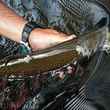
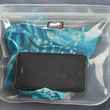





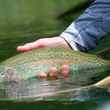





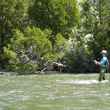









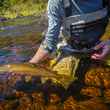

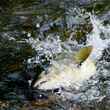
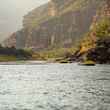
Comments
Rod Hamilton replied on Permalink
Hey Chad, interesting article on footwear, bottom line is I guess you learned a thing or two and mostly figured out that doing your research in advance is the best preparation for a trip. After walking the flats for twenty years I have learned plenty about flats foots boots and flats foot wear. I've tried them all and have pretty firm opinions on what works and what is hype. If you are fishing out of a boat anything that is light weight and covers your feet works perfectly. Socks and/or bare feet are best for feeling the line. If you are wading all day on your own, I have gone in completely the opposite direction then suggested. After wading ten miles over eight hours, believe me you want the lightest product on the market. I wear zip up neoprene diving boots with a hard sole. There are a number of manufacturers catching up with that trend now. if you are wading where there is coral, safety comes first. Heavy protective boots are a must. Why do I carry Duck Tape? To wrap up the toes, feet and ankles of anglers that have blisters everywhere from their "out of the box boots". Want to ruin a seven day fishing trip? Wear brand new boots on day one. Hope this helps.
Chad Shmukler replied on Permalink
Rod -
Thanks for the thoughts. Your experience vastly outweighs my own, but I think we're mostly on the same page.
For me, on the boat always = bare feet. I step on the line religiously. It I couldn't feel it, it'd be a disaster.
DIY or long wades are perhaps the most dependent on conditions. If it is going to be tough wading (lots of coral, rocks, changes in surface) I sometimes opt for the ankle support of a full boot (and thankfully full boots are getting lighter and lighter), but if I know the conditions and don't have to worry about tough conditions, the lightweight booties always win out.
I think sockwear in boots is important too -- I find blisters are more common without socks or with neoprene guard socks than they are with a good, tight fitting fabric (i.e. Polypropylene) wading sock.
John Andrew replied on Permalink
Hi Chad,
I have several comments about footwear for wading. I usually spend 2 - 3 months a year flats fishing and over the years I have had some real problems with conventional flats boots. Originally I used Simms Flats sneakers but found that they lasted about 30-40 days and then fell apart. I went through 3 pairs. If you look at them closely they are a really cheaply made Chinese boot that is expensive for what you get. Just compare them to an equivalently priced hiking boot and you will see what I mean. The other issue with the boots is that the inner lining allows very fine mud to go through the fabric and form lumps which are very uncomfortable. On one trip to Acklins, Rod Hamilton and I had to take knives to inside of our boots to slash the lumps. I have used Simms as an example but the other don't seem any better. Patagonia's are also expensive. I have also tried wearing high top running shoes - not so good, a shoe called Natives - bad idea. I see some guys fishing in Tivas - a sure way to have sand and mud bothering your feet.
The other big issue is the weight. Wet conventional flats boots weigh about 3 pounds more that light weight kayak boots or water shoes. I estimate I walk about 1 to 2 feet per step while wading and searching for bonefish. That equates to about 2500 to 5000 steps per mile. Many days I will log 5 miles. That's a lot of steps and if you are lifting 3 pounds extra per every 2 steps, well you do the math - it works out to a number of tons per day!! No wonder guys are whipped at the end of a walking and wading day.
I am using NRS water shoes for wading in rocky areas and kayak boots with a thick sole for easy wading in sandy areas. My feet don't get tired.
Although I have not tried them yet, there are some great looking light weight hiking boots that look great.
In summary I think there are better alternatives that the offerings of the fishing equipment companies.
Yours, John Andrew
Jonathan Winthrop replied on Permalink
Very useful discussion on footgear. On Eleuthera, North Riding Pt, Joulters, I have had good luck with Keen sandals with toe protection. Got to wear cotton socks too (grey, from Wal-Mart or such).
At South Andros last May lodge insisted on (loaner) boots, but I think my Keens would have been fine. Boots are indeed very heavy to transport, and to walk.
Anonymous replied on Permalink
I have worn Orvis and Simms heavy stiff uncomfortable boots in past and both have given me
painful blisters on top of big and little toes no matter what socks are used and trying different sized boots .
Jack Keller replied on Permalink
And what about stingrays? Around here we've got lots and no flats bootie is going to turn a ray spine. You will need something more substantial because shuffling your feet doesn't always work.
Pages